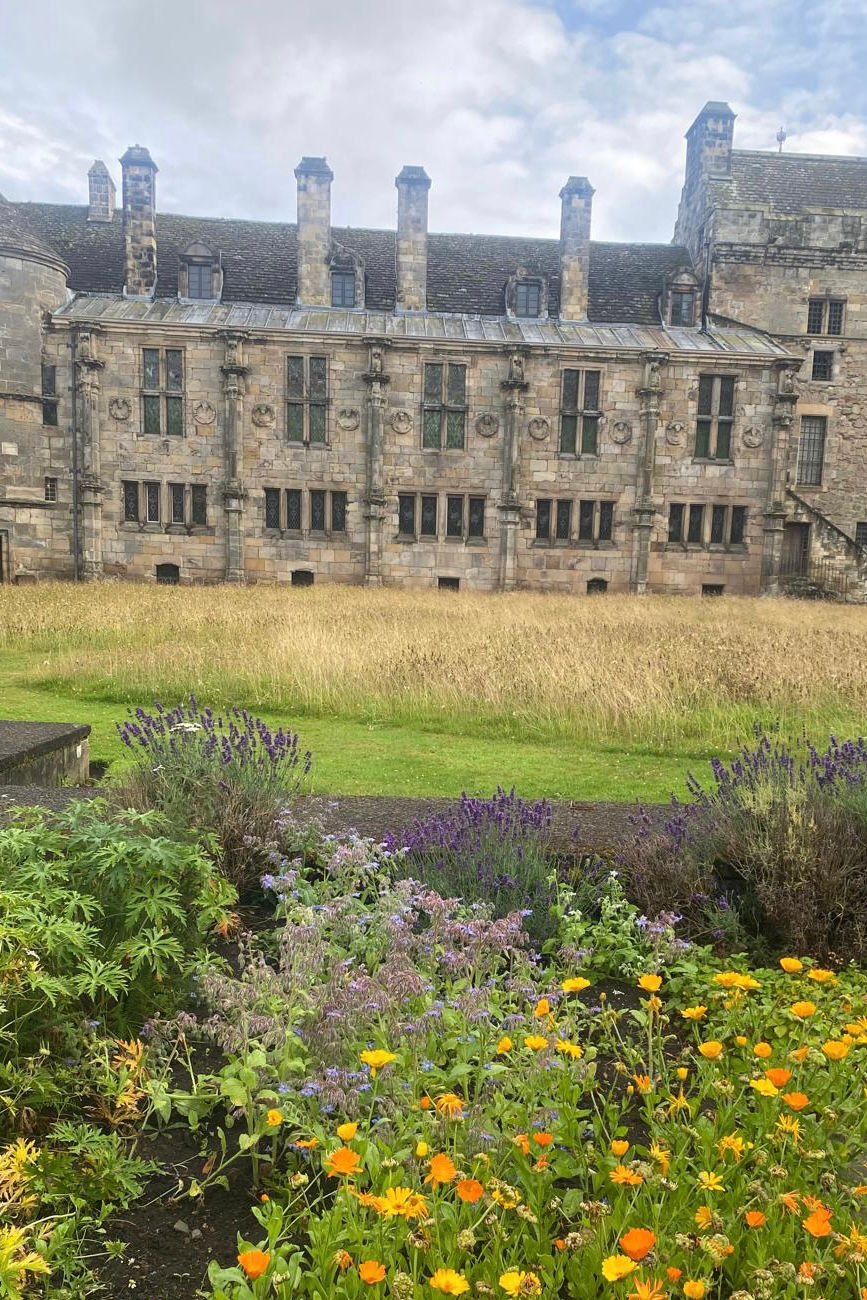An atmospheric evening in the gardens of Falkland Palace
- The Gardener

- Jul 20
- 4 min read
Updated: Jul 26
Last week, we had the privilege of accompanying former Head Gardener Susan on a walk around the gardens of the National Trust for Scotland property, Falkland Palace. While it had been raining during the day, fortunately the clouds lifted, and the sun even made a fleeting appearance!
Falkland Palace is historically best known for its connections with James V and VI, and of course Mary Queen of Scots (it was a favourite country retreat of hers). These days, however, probably more come because of the village’s connections with hit TV series Outlander, but we were there for the Palace gardens. And quite the showpiece they are.

It is a treat being able to see a garden out of hours, when all (other than our small group) have gone home. And to see a place through the eyes of someone who has clearly invested so much of their being, thought, care and energy in the garden is quite a privilege. It’s the piece of the jigsaw you don’t normally see when garden-visiting. There is, unquestionably, a undefinable link between Head Gardener and garden, and it’s so much more than ensuring mown lawns and weed-free borders. Get that partnership right and the magic follows.
I think a great garden is one which makes you feel something. Call it atmosphere or ambiance, it is, for sure, easier to find in an older garden. And Falkland has atmosphere in barrowloads.

Yes, the location has a lot to do with it. Not every garden has the honeyed sandstone of an ancient royal palace as its backdrop nor the borrowed landscape of East Lomond hill with its mist-covered peak. This sets the garden up for success, but this is not the original royal palace garden, or even a reconstruction that you see today. But it is historically significant in its own right.
The garden is actually comparatively modern - mid-20th Century and designed along Arts & Crafts principles. It was commissioned by Major Michael Crichton Stuart (grandson of the 3rd Marquess of Bute, who restored the palace) a his wife, Barbara, to complement the building, there being no traces of, nor plans for, the original palace garden. Major Michael brought in the famous garden designer of his day, Percy Cane, who was admittedly better known for his designs in England, to create a garden that would complement and accentuate the architecture of the palace. Cane elected to combine a series of long views that would link the palace to the garden and accentuate the palace’s straight lines, with a series of very large island beds, planted with a palette of trees, shrubs and herbaceous. Island beds would have been very novel in those days (arguably it wasn’t really until the 70’s that these took off, promoted by the likes of Alan Bloom of Bressingham), but Cane managed to combine both the formal and informal in his designs. Yes, it is a former royal palace but the Crichton Stuarts also wanted a family garden for their four children. And the Trust have managed to maintain this balance. It does, for sure, feel like a large family garden in places with its vast swirling lawns and giant chess set!
But be under no illusion: this is a horticulturally-rich and beautifully-designed garden. With its strong Arts & Crafts ‘feel’, there are formal areas, including two raised lily ponds, beautiful urns and a fine (currently being restored) Victorian greenhouse. Many of Cane’s plantings still remain including some outanding shrubs and trees (including a huge cut-leaved beech and Acer ‘Crimson King’ ) and the Trust have been gradually restoring the island beds as far as possible to Cane’s original planting plans, including a long lupin display border.

For gardener and non-gardener, there is a lot to see here, but during July and August the long, deep herbaceous borders are a sight to behold, beautifully set against the backdrop of the high garden walls. There is a fine cuttings garden too round the back of the royal tennis court and one shouldn’t miss the physic garden, where the Trust are growing a range of plants that would have been used for medicinal purposes at the time of Mary Queen of Scots.

For those in search of something a little more natural or informal, the woodland and orchard areas are well worth a visit. Look out for red squirrels in the woodland and follow the grass paths through the wildflower tapestry that grows underneath the heritage fruit trees in the orchard. This area has the most peaceful ambiance with views through the lime trees to the palace beyond and the wider borrowed landscape of Falkland village and East Lomond Hill glowering above.

Falkland Palace is fortunate. On the macro scale, it is in the hands of the National Trust for Scotland, a stable and well- regarded organisation which knows how to curate and proactively manage these complex, historic properties. It occupies a large footprint in what must be one of Scotland’s most beautiful villages but its relationship with the village appears to be one of symbiosis, not dominance. The Crichton Stuarts still remain closely engaged, maintaining that link with the past, and the property is clearly led, managed and run by staff and volunteers who love the place, who recognise its significance and who relish sharing these deep veins of Scottish history with visitors.
But we finish back in the gardens where the current Head Gardener has the benefit of working alongside his predecessor who in turn ‘learned’ the garden from her predecessor. Continuity, but also a shared ethos. It’s clear from our tour with Susan that, for her, and others caring for this place, Falkland is so much more than just a job.

For further information on Falkland Palace and Gardens, click here.
This is not a paid promotion.




Comments